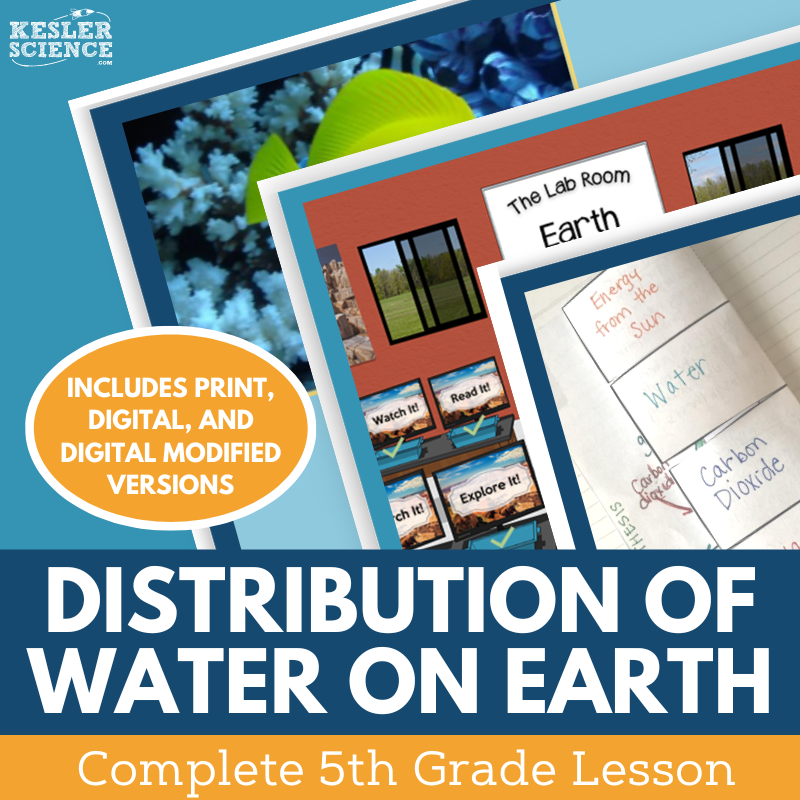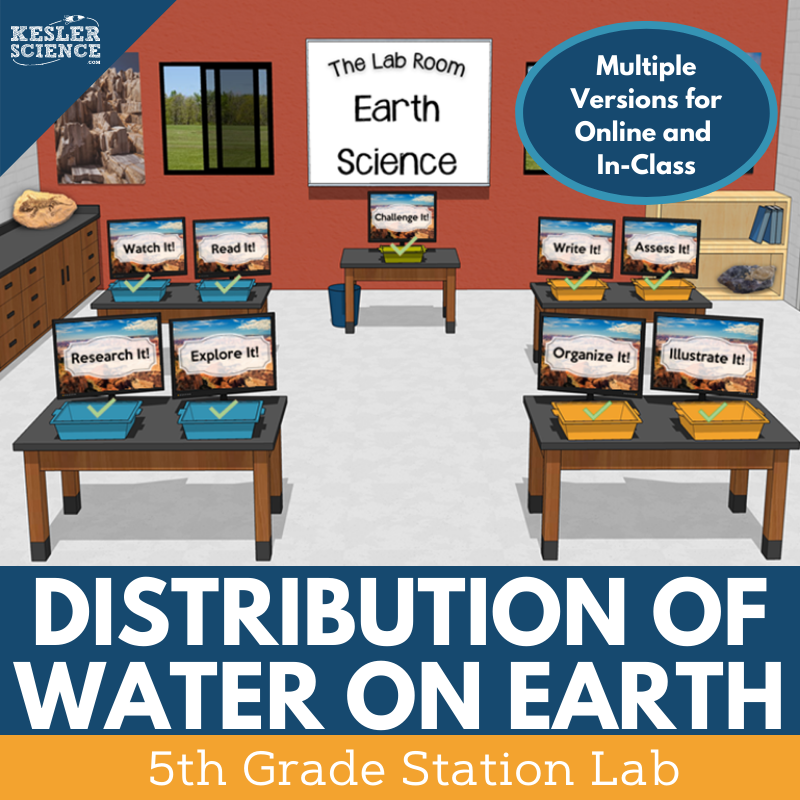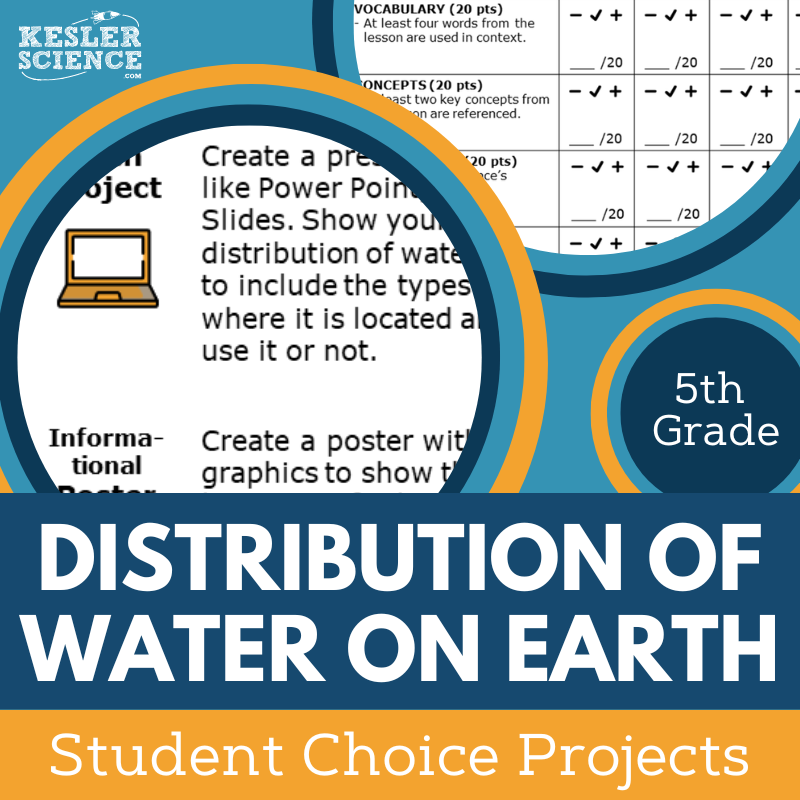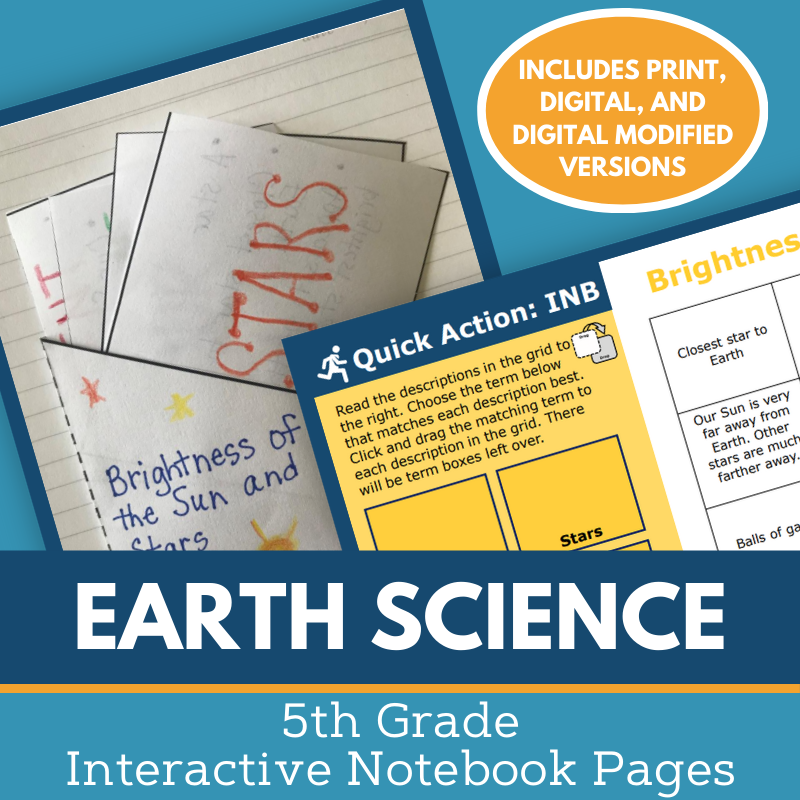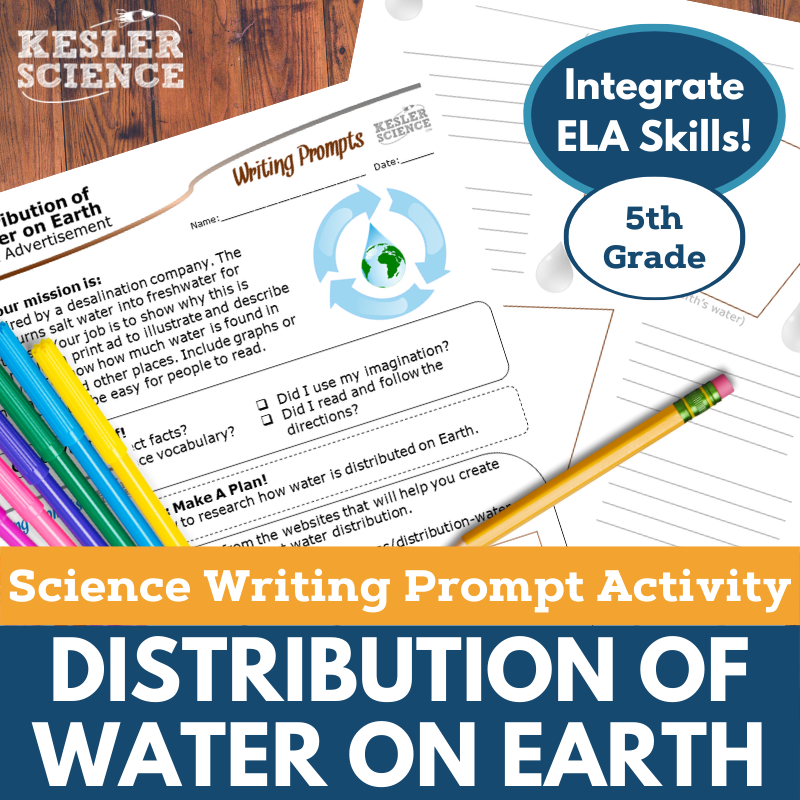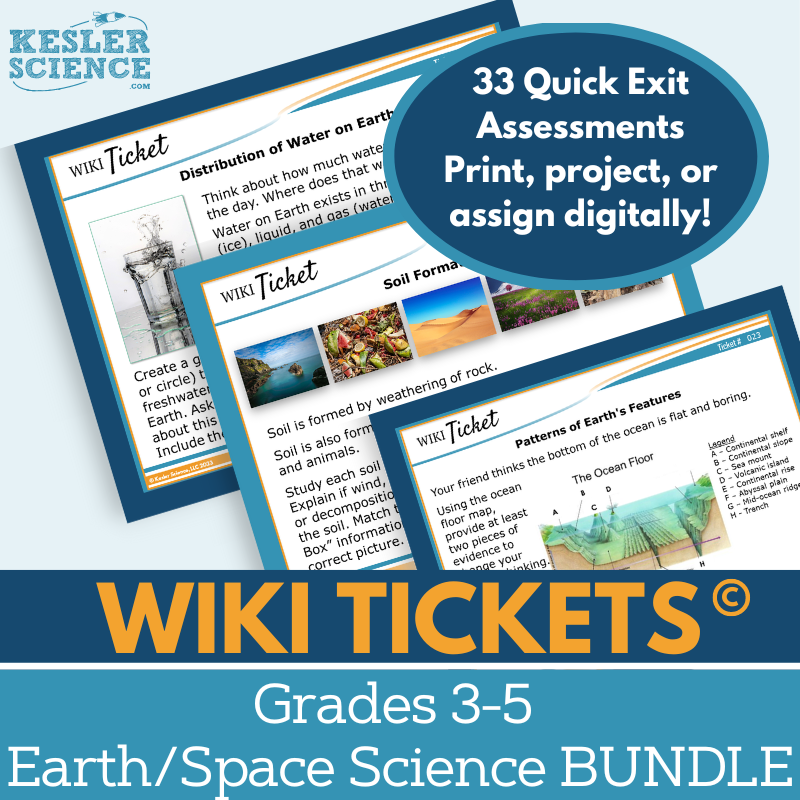Distribution of Water on Earth Activities for 5th Grade Science
The Kesler Science Distribution of Water on Earth 5E Lesson offers an engaging unit designed for elementary students to explore Earth's water distribution. The resources below will give students a comprehensive understanding of the distribution of water on Earth. All of the following materials are also included in the Kesler Science Membership.
The Kesler Science Distribution of Water on Earth 5E Lesson provides an engaging and comprehensive unit designed for elementary students to explore how water is distributed on our planet. Aligned with the 5E Model—Engagement, Exploration, Explanation, Elaboration, and Evaluation—this lesson includes editable presentations, differentiated worksheets, interactive notebook pages in English and Spanish, student-choice projects, and STAAR-aligned assessments.
Students investigate essential questions about Earth's water distribution through a differentiated, multimodal station lab with nine interactive stations. Activities range from hands-on experiments and differentiated reading passages in Spanish and English, to digital research and videos. Students also demonstrate their understanding by organizing concepts, writing explanations, illustrating ideas, and completing formal assessments.
For elaboration, students can deepen their learning through choice projects suitable for classroom or home use. Designed for flexibility, all resources are fully editable, printable, and digital-friendly, making them ideal for both classroom and virtual learning environments. This unit supports diverse learners, fostering engagement and student success.
The Kesler Science Distribution of Water on Earth 5E Lesson provides an engaging and comprehensive unit designed for elementary students to explore how water is distributed on our planet. Aligned with the 5E Model—Engagement, Exploration, Explanation, Elaboration, and Evaluation—this lesson includes editable presentations, differentiated worksheets, interactive notebook pages in English and Spanish, student-choice projects, and STAAR-aligned assessments.
Students investigate essential questions about Earth's water distribution through a differentiated, multimodal station lab with nine interactive stations. Activities range from hands-on experiments and differentiated reading passages in Spanish and English, to digital research and videos. Students also demonstrate their understanding by organizing concepts, writing explanations, illustrating ideas, and completing formal assessments.
For elaboration, students can deepen their learning through choice projects suitable for classroom or home use. Designed for flexibility, all resources are fully editable, printable, and digital-friendly, making them ideal for both classroom and virtual learning environments. This unit supports diverse learners, fostering engagement and student success.
Engage your 5th graders with this student-led station lab aligned to NGSS standards about the distribution of water on Earth. Designed for both in-class and virtual learning, students direct their own learning through eight interactive stations, plus a bonus challenge station for early finishers.
Students explore water distribution through multimodal activities including experiments, research, reading passages (available in English and Spanish), and educational videos. They demonstrate understanding through organizing manipulatives, illustrating models, writing short responses, and completing task-card assessments. The bonus station offers advanced learners crosswords, games, and mini-projects.
This modular, differentiated resource promotes active engagement, critical thinking, and independent learning, supporting various classroom setups.
Engage your 5th graders with this student-led station lab aligned to NGSS standards about the distribution of water on Earth. Designed for both in-class and virtual learning, students direct their own learning through eight interactive stations, plus a bonus challenge station for early finishers.
Students explore water distribution through multimodal activities including experiments, research, reading passages (available in English and Spanish), and educational videos. They demonstrate understanding through organizing manipulatives, illustrating models, writing short responses, and completing task-card assessments. The bonus station offers advanced learners crosswords, games, and mini-projects.
This modular, differentiated resource promotes active engagement, critical thinking, and independent learning, supporting various classroom setups.
The Distribution of Water on Earth Student Choice Projects align with NGSS standards, allowing 5th-grade students to select a project suited to their preferred style. Students choose from nine provided project options or create their own, all clearly outlined on an included project page. An editable rubric supports assessments by teachers, peers, or students themselves, evaluating vocabulary, concepts, presentation, clarity, and accuracy.
These flexible, multimodal projects let students creatively demonstrate their understanding. Two project page versions offer differentiation, providing modified options to support students needing remediation and combinations of projects for advanced learners seeking additional challenges.
Projects utilize common classroom materials like paper, markers, scissors, and optional crafting supplies. Many activities can also be completed digitally.
The Distribution of Water on Earth Student Choice Projects align with NGSS standards, allowing 5th-grade students to select a project suited to their preferred style. Students choose from nine provided project options or create their own, all clearly outlined on an included project page. An editable rubric supports assessments by teachers, peers, or students themselves, evaluating vocabulary, concepts, presentation, clarity, and accuracy.
These flexible, multimodal projects let students creatively demonstrate their understanding. Two project page versions offer differentiation, providing modified options to support students needing remediation and combinations of projects for advanced learners seeking additional challenges.
Projects utilize common classroom materials like paper, markers, scissors, and optional crafting supplies. Many activities can also be completed digitally.
This 5th Grade Earth Science Interactive Notebook is essential for teachers seeking to maximize student engagement when teaching elementary earth science concepts. It is versatile for traditional classrooms, 1:1 digital settings, or distance learning, providing both digital and paper versions. Digital resources feature interactive PowerPoint files compatible with Google Slides, MS Teams, Schoology, and Canvas, reflection pages, note-taking spaces, teacher answer keys, and modified versions for students needing accommodations. The paper resources include blank templates, pre-filled versions for absent or modified instruction students, and color photos demonstrating template usage.
Topics covered include the brightness of the Sun and stars, observable patterns of the sky, Earth's spheres, the distribution of water on Earth, protecting Earth's resources, sedimentary rock and fossil fuels, changes to Earth's surface, weather and climate, the water cycle, Earth’s rotation, and the Sun, the Moon, and Earth. These notebook templates also integrate seamlessly into Kesler Science 5E Lessons.
This 5th Grade Earth Science Interactive Notebook is essential for teachers seeking to maximize student engagement when teaching elementary earth science concepts. It is versatile for traditional classrooms, 1:1 digital settings, or distance learning, providing both digital and paper versions. Digital resources feature interactive PowerPoint files compatible with Google Slides, MS Teams, Schoology, and Canvas, reflection pages, note-taking spaces, teacher answer keys, and modified versions for students needing accommodations. The paper resources include blank templates, pre-filled versions for absent or modified instruction students, and color photos demonstrating template usage.
Topics covered include the brightness of the Sun and stars, observable patterns of the sky, Earth's spheres, the distribution of water on Earth, protecting Earth's resources, sedimentary rock and fossil fuels, changes to Earth's surface, weather and climate, the water cycle, Earth’s rotation, and the Sun, the Moon, and Earth. These notebook templates also integrate seamlessly into Kesler Science 5E Lessons.
The Distribution of Water on Earth Writing Prompt Activity engages 5th-grade students in creating a print advertisement to reinforce their understanding of Earth's water distribution. Aligned with NGSS 5-ESS2-2, this low-prep, student-centered activity enhances science reasoning and creativity, suitable for both in-person and virtual learning.
The resource includes teacher directions with an answer guide, project ideas, and rubrics. It provides projection and print handouts in full and half-sheet sizes, along with a digital interactive version compatible with PowerPoint and Google Slides. This writing prompt is ideal for cross-curricular integration, formative assessments, student choice projects, early finisher enrichment, extra credit, make-up work, TELPAS samples, or differentiation. Display student work on bulletin boards or compile them into student anthologies.
The Distribution of Water on Earth Writing Prompt Activity engages 5th-grade students in creating a print advertisement to reinforce their understanding of Earth's water distribution. Aligned with NGSS 5-ESS2-2, this low-prep, student-centered activity enhances science reasoning and creativity, suitable for both in-person and virtual learning.
The resource includes teacher directions with an answer guide, project ideas, and rubrics. It provides projection and print handouts in full and half-sheet sizes, along with a digital interactive version compatible with PowerPoint and Google Slides. This writing prompt is ideal for cross-curricular integration, formative assessments, student choice projects, early finisher enrichment, extra credit, make-up work, TELPAS samples, or differentiation. Display student work on bulletin boards or compile them into student anthologies.
The WIKI Tickets© Formative Assessments provide engaging, colorful ways to quickly gauge student understanding in 3rd–5th grade science. The Earth/Space Science Set includes 33 topics, each offering five flexible formats: a full-screen projection option, three printable handouts (full, split, and quarter-page sizes), and an interactive digital version compatible with PowerPoint and Google Slides.
Aligned with NGSS and TEKS standards, these assessments cover essential topics such as weather patterns, Earth's surface changes, natural resources, the solar system, the water cycle, and erosion. They work effectively as exit tickets, bellringers, or quick checks, suitable for both in-person and virtual classrooms.
The WIKI Tickets© Formative Assessments provide engaging, colorful ways to quickly gauge student understanding in 3rd–5th grade science. The Earth/Space Science Set includes 33 topics, each offering five flexible formats: a full-screen projection option, three printable handouts (full, split, and quarter-page sizes), and an interactive digital version compatible with PowerPoint and Google Slides.
Aligned with NGSS and TEKS standards, these assessments cover essential topics such as weather patterns, Earth's surface changes, natural resources, the solar system, the water cycle, and erosion. They work effectively as exit tickets, bellringers, or quick checks, suitable for both in-person and virtual classrooms.
Year-Round Resources
These year-round activities will increase your students' understanding of many middle school science topics. All of these activities are also included in the Kesler Science Membership.
Visual Data & Graphing
You're not alone if your students struggle with understanding graphs, charts, and tables. It's a skill that takes an enormous amount of practice. This resource will help students build a strong foundation in analyzing data and creating their own data visualizations.
Bell Ringers and Warm-Ups
These middle school science bell ringers are an excellent way to engage your students as soon as they walk into your classroom. This comprehensive FULL YEAR resource includes everything you need to start off each science class with an interesting warm-up activity.
Review Board Games
Each game board has been carefully designed to keep students engaged. There are 10 different action spaces on each board and dozens of question cards. All of the actions are related to science concepts and keep the students motivated throughout the game.
Each game is ready to play. Simply print out the board and the cards and let the students enjoy reviewing nine different units.
Essential Questions and Standards
Below are the essential questions and standards associated with the lessons and activities included in the distribution of water on Earth unit. This topic is only one of more than 100 middle school science topics included in the Kesler Science Membership.
-
How is water distributed on Earth?
-
How can we measure the distribution of water?
-
NGSS - 5-ESS2-2 Distribution of Water on Earth
Kesler Science Membership
Imagine never having to search for another middle school science lesson again. The membership gives you access to ALL of the Kesler Science products in one place (Yes, including everything above).
Say goodbye to long hours of lesson prep.

